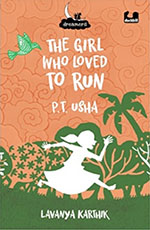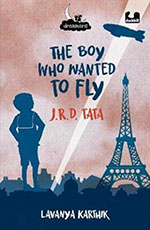Biography is an evergreen genre. The urge to know about famous people’s lives seems fairly insatiable as can be seen from any major publisher’s list. And yet, these slim books by Lavanya Karthik manage to stand out, for they deal not with the great glories of the famous persons they are about but with small occasions from their childhood that sowed the seeds for the direction their lives would take in the future. Each story is crafted from the perspective of the child that was.
JRD Tata, the man behind Air India (which was originally Tata Airlines) was fascinated by planes as a boy. His unique childhood, spent partly in France and partly in India owing to his mixed heritage, his introduction to bomber aircrafts during World War I and to gymnastic fliers after the end of the war, and his first ride in a biplane are entirely from a child’ point of view. He declares to his mother that he will fly too. And when she asks if he wanted to do tricks or drop bombs across enemy lines, he says he wants to connect worlds. I wonder whether there is any record of young Jeh saying such a thing, or if this delightful phrase came out of the author’s imagination—either way, a fabulous imagery for what he eventually did!
Satyajit Ray—a boy called Manik, was fascinated by the play of light and shadow. The author hints at the legacy of creative work that he inherited through a mention of the notebooks Manik’s father filled with poems and drawings. Tragedy—in the form of loss of this father at a very young age—too is depicted hauntingly through the imagery of shadows: ‘The shadows that settled under Ma’s eyes after Baba died. The shadows that pooled on the floor of the press [run by his father] as, one by one, the machines fell silent.’ Manik saw stories in the play of light and shade; like his father, he drew and he wrote. And when the time was right, he pictured the stories with their subtle nuances of light and shadow in film.
The Golden Girl of Indian athletics was just another tongue-tied schoolgirl. A sports teacher saw her potential when she was merely fooling around with her friends and encouraged her to compete with the district champion, a girl much older and bigger than herself. Little Usha was perplexed and unsure, but his belief in her made her imagine what she felt like while running. The wind in her face and her lungs. The sensation of flying. The rest, as they say, is history.
The illustrations in these three delightful books—complex collages made with sketches, ink, superimposed photographs of faces, and drawing on the specific contexts (late 19th to early 20th century portraits of the Parsi community, Sukumar Ray’s artwork and Kerala murals)—perfectly complement the texts. Short, delightful, educative reads!

November 2023, volume 47, No 11

